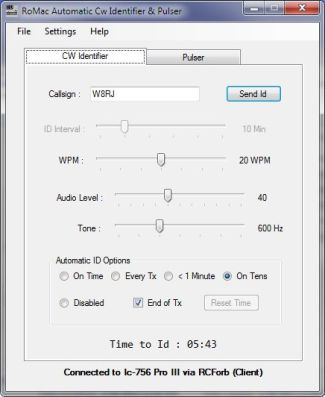RoMac Software's Automatic CW identifier and Tuning Pulser utilizes your
present computer's sound card to automatically send your callsign at
preset intervals, to insure your stations compliance with FCC
regulations. Also incorporated is a Tuning Pulser aka Pecker, to aid in
reducing stress and heat while tuning your amplifier, antenna tuner,
etc.
The RoMac Automatic Identifier and Pulser has the
capability to run a Rig Control program sharing the same serial port,
provided the proper interface has proper hardware, such as the West
Mountain RigBlaster Pro. Kenwood owners should read
this article...
The program will run in the windows tray so it will not take
up valuable screen real estate. also available is an option to display
a small time to ID clock anywhere on the screen you want.
Select whether to send the CW Id either at the
beginning of a transmission or at the end .
You can make sure your station is properly identified
while tuning up. You have the option to send the CW Id at the end tuning
with the Pulser. No more forgetting to ID properly!No
more programming EPROM's to change callsigns. Just type in your new
callsign and you're ready to go. Great for that new vanity call you want
in the future.
CW speed speed is fully adjustable from 5
to 40 wpm, ID time interval ranges from 1 to 30 minutes in
one second increments, and the tone of the CW note is
adjustable from 500 Hz to 1000 Hz.
Choose from three convenient options of
when to send you station identification, to ensure your
compliance with the FCC regulations.
New
Support for CAT commands
for many popular radios. Support for even a simple sound
card interface such as the RigBlaster Plug and Play in
combination with the new CAT support.
When using CAT support, the interface to your radio may be
as simple as an isolation transformer.
See the
FAQ for specific issues with the
West Mountain RigBlaster Pro.
If you don't presently
have a
sound card interface a complete schematic for a basic yet
fully functional interface is included
here and
in the help files. All parts are available at your local
Radio Shack store.
All settings are saved from session to
session. All sound card settings are restored when quitting
the software. Just start the software running and your
station is ready to be compliant with the FCC regulations.
Any sound card
that is installed in your system may now be selected
independently from the windows default sound device.
The Pulser aka "Pulse Tuner" sends a
series of short audio tones with a duty cycle as low as 20%
to the audio input of your radio enabling you to tune your
amplifier or antenna tuner, without worrying about
overheating those expensive amplifier tubes or antenna tuner
parts.
Take your time, tuning your amplifier
optimally using the RoMac Pulser. Considering the cost of
replacing amplifier tubes, the RoMac Pulser is a bargain!
Some
"Tuning Pulsers" merely key your radio using the CW jack on
your radio. RoMac Pulser sends a series of short audio tones
(pulses) to you microphone input. The pulses are also "shaped",
so the amplitude of the pulse slopes up to peak amplitude.
This further reduces heat and stress on you expensive
amplifier tubes and parts.
The RoMac Pulser is compatible with all
transmitters, from Icom, Kenwood, TenTec, Yaesu, Collins,
Drake and others. Will work with any amplifier on the market
today or any older amplifier.
The speed and duty cycle of the audio
tones are both adjustable. All settings are saved from
session to session.
The free evaluation software runs for 10
hours of cumulative running time.
Purchase License Key
|
